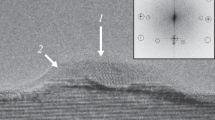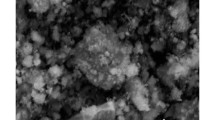Abstract
Silicide formation in bulk Fe-Si diffusion couples was studied. Couples were annealed in evacuated quartz capsules at temperatures ranging from 700 to 800 °C and for times as long as about 2 months. Microstructures were subsequently analyzed using scanning electron microscopy (SEM) and energy dispersive x-ray (EDX) spectroscopy. Three silicide phases were found in all couples examined— FeSi2, FeSi, and Fe3Si. Results concerning Fe3Si disagreed with the present Fe-Si phase diagram. The silicide is stoichiometric with almost no compositional range, whereas the phase diagram predicts a wide range of homogeneity. Growth kinetics for FeSi2 were quantified, and the activation energy for diffusion controlled βFeSi2 layer growth was calculated to be 0.83 eV or 80.4 kJ/mol.
Similar content being viewed by others
Cited References
M.C. Bost and J.E. Mahan,“Optical Properties of Semiconducting Iron Disilicide Thin Films,”J. Appl, Phys., 58(7), 2696–2703 (1985).
M.C. Bost and J.E. Mahan,“A Clarification of the Index of Refrac- tion of Beta-Iron Silicide,”J. Appl. Phys., 64(4),2034–2037 (1988).
A. Rizzi, H. Moritz, and H. Liith, “Growth and Characterization of Semiconducting FeSi2 Thin-Layers on Si (111), Proceedings of the Society of Photo-optical Instrumentation Engineers (SPIE), pub- lished by International Society for Optical Engineering, Belling- ham, Washington, Vol. 1361, Part 2,827-833 (1990).
A. Rizzi, H. Moritz, and H. Liith,“Electronic and Vibrational Prop- erties of Semiconducting Crystalline FeSi2 layers Grown on Si (111),”J. Vac. Sci. Tedmol. A, 9,912–916 (1991).
K. Lefki, P. Muret, N. Cherief, and R.C. Cinti,“Optical and Electri- cal Properties of Beta-FeSi2 Epitaxial Thin Films on Silicon Sub- strates,”J. Appl. Phys., 69,1,352–357 (1991).
M. De Crescenzi, G. Gaggiotti, N. Motta, F. Patella, A. Balzarotti, G. Mattogno, and J. Derrien, “β-FeSi2 on Si (111),Surf. Sci., 251/252, 175–179(1991).
C. A. Dimitriadis and J.H. Werner, “Growth Mechanism and Mor- phology of Semiconducting FeSi2 Films,”J. Appl. Phys., 68,1,93- 98(1990).
N.E. Christensen, “Electronic Structure of β-FeSi2,”Phys. Rev. B, 42,11,7148–7153(1990).
W. Raunau, H. Niehus, T. Schilling, and G. Comsa,“Scanning Tun- neling Microscopy and Spectroscopy of Iron Silicide Epitaxially Grown on Si (111),”Surf. Sci, 286,203–211 (1993).
W. Raunau, H. Niehus, and G. Comsa, “Epitaxial Iron Silicides on Si (001): An Investigation with Scanning Tunneling Microscopy and Spectroscopy,”Surf. Sci. Lett., 284,1–2, L375-L383 (1993).
M. Powalla and K. Herz, “Crystallization of Coevaporated b-FeSi2 Thin Films,”Appl. Surf Sci., 70/71,593–597(1993).
Ch. Stuhlmann, J. Schmidt, and H. Ibach, “Semiconducting Iron Disilicide Films on Si (111): A High Resolution Electron Energy Loss Spectroscopy Study,”J. Appl. Phys., 72, 12, 5905–5911 (1992).
K. Radermacher, O. Skeide, R. Carius, J. Klomfaβ, and S. Mantl, “Electronic and Optical Properties of FeSi2 Layers,”Mater Res. Soc. Symp. Proc., 320,115–120 (1994).
B. Rosen, D. Freundt, Ch. Dieker, D. Gerthsen, A. Rizzi, R. Carius, and H. Liith, “Characterization of Beta-FeSi2 Heterostructures Grown by Gas-Source-MBE,”Maler Res. Soc. Symp. Proc., 320, 139–144(1994).
O. Kubaschewski,Iron—Binary Phase Diagrams, Springer-Verlag, NewYork,p. 136–139(1982).
Y. Dusausoy, J. Protas, R. Wandji, and B. Roques,Acta. Crystallogr. B, 27,1209(1971).
T. Rosenqvist,Principles of Extractive Metallurgy, 2nd ed., McGraw-Hill, New York (1983).
F.A. Shunk,Constitution of Binary Alloys 2nd supplement, McGraw-Hill, New York (1969).
K. Radermacher, S. Mantl, Ch. Dieker, H. Lüth, and C. Freiburg, “Growth Kinetics of Iron Silicides Fabricated by Solid Phase Epi- taxy or Ion Beam Synthesis,”Thin Solid Films, 215,76–83 (1992).
U. Erlesand, M. Östling, and K. Bodén, ”Formation of Iron Dis- ilicide on Amorphous Silicon,”Appl. Surf. Sci., 53,153–158 (1991).
Author information
Authors and Affiliations
Rights and permissions
About this article
Cite this article
Baldwin, N.R., Ivey, D.G. Iron slicide formation in bulk iron-silicon diffusion couples. JPE 16, 300–307 (1995). https://doi.org/10.1007/BF02645285
Received:
Revised:
Published:
Issue Date:
DOI: https://doi.org/10.1007/BF02645285




